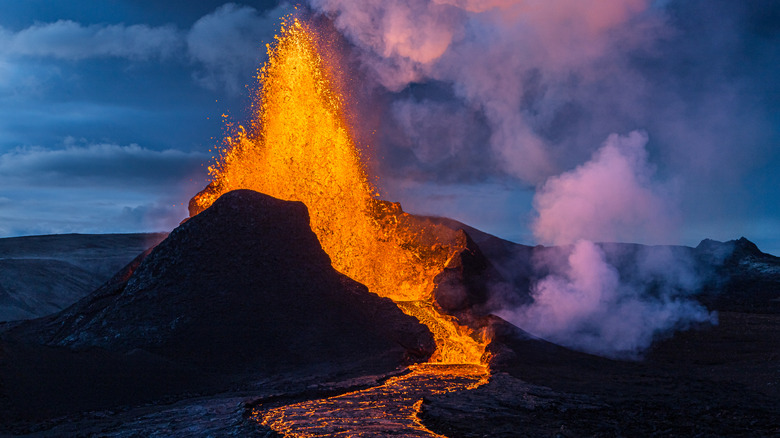Stages Of A Volcano Eruption
Volcanologists classify a volcano's eruptions by its type and qualitative standards, as each volcano type behaves differently. Geologists categorize volcanoes into three major groups: shield cone, cinder cone, and composite cone, also known as stratovolcanoes, which represent 60% of the world's volcanoes.
Volcanic Explosivity Index
Volcanologists rank eruptions based on the Volcanic Explosivity Index, which includes the debris that ejects during the eruption and runs from 0 to 8. Shield volcanoes don't erupt explosively, which explains a zero VEI, as lava simply oozes over the brim of the magma pool without any extra debris. The top VEI ranking of 8 defines any volcano that ejects 240 cubic miles or more of ash and rock. Typically, this ranking only applies to supervolcanoes.
Six eruption types
In addition to the VEI, volcanologists have identified six types of eruptions: Icelandic, Hawaiian, Strombolian, Vulcanian, Pelean, and Plinian, some of which are named for the type of volcano, a specific volcano, or the person who reported on the eruption. Pelean eruptions, for example, are named for the 1902 Mount Pele eruption. Plinian eruptions, named for Pliny the Younger, who objectively detailed the eruption of Mount Vesuvius in 79 A.D., represent the most explosive type of eruptions. Volcanoes are not limited to a single eruptive behavior classification, as Mount St. Helens exhibited complex eruptions of different types during its eruptive cycle.
Earthquake swarms and gas emissions
As magma moves beneath a volcano, this activity creates a swarm of earthquakes that often increase in intensity and strength. Fumaroles, which are fissures that open to vent gases, begin spewing steam, carbon dioxide, sulfur, and other poisonous gases. An uptick in gas emissions and earthquakes often signal a coming eruption, although it may precede the eruption by years. Swarms and gas emissions are usually the first stage of an eruption.
Initial venting
A sign that a volcanic eruption may be imminent begins with the expulsion of ash and steam through newly opened vents. Phreatic eruptions happen when the magma heats surface or groundwater that is released through vents and fissures.
Dome buildup and dome failures
The next stage in the volcano's eruption is the buildup of a lava dome, identified by using scientific equipment. While the lava dome buildup may not be visible to the naked eye, volcanologists use GPS satellites and other equipment to note this activity. As the volcano becomes more active, it goes through a series of dome buildups and collapses that eventually lead to violent eruptions.
Icelandic, Hawaiian, Strombolian, and Vulcanian eruptions
The activity a volcano exhibits that leads to an eruption may occur over several years, months, weeks, or days. After a series of lava dome buildups and failures, and depending on the volcano type, the volcano may exhibit an Icelandic, Hawaiian, Strombolian, Vulcanian, Pelean, or Plinian eruption. Icelandic eruptions — like Hawaiian shield volcano eruptions — exhibit a less viscous, runnier lava compared with Hawaiian eruptions and spread the lava across a greater surface. Strombolian eruptions exhibit distinct, short bursts of thick or pasty lava at the mouth of the volcano and can include hardened blobs of volcanic glass, lava bombs, chunks of lava, and small lava flows. Vulcanian eruptions are depicted by short and violent explosions of viscous magma.
Pelean and Plinian eruptions
Strombolian and Vulcanian eruptions often precede Pelean and Plinian eruptions, the two most violent of eruptions. Both eruption types involve explosive pyroclastic flows that speed across the landscape. Of the two, Plinian eruptions are the strongest and most violent with a plume that can ascend 50,000 feet into the air, but both are equally devastating. In 1902, when Mount Pele erupted, more than 29,000 people were killed almost instantly by the pyroclastic flow composed of ash and gas. When Mount Vesuvius erupted in 79 A.D., people in the city of Pompeii were buried by hot ash as high as 17 feet across the city in some places.
